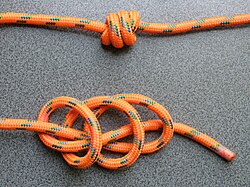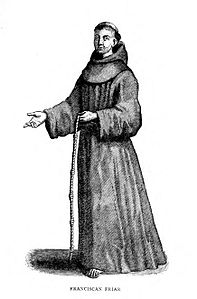Franciscan knot
| Franciscan knot | |
|---|---|

|
|
| Type | Stopper, ornamental |
| application | Stopper knots , belt knots , decorative knots |
| Ashley No. | 2203, (517), (800) |
| Synonyms | Triple overhand knot , "Capuchin knot " |
| English | Monkey's Fist, Threefold Overhand Knot, Multiple Overhand knot, Coil Knot |
| List of nodes | |
The Franciscan knot is a triple overhand knot that is used as a decorative stopper knot to thicken a rope. It is also used as a military decorative knot.
Names and history

The name Franciscan knot is derived from the use of the knot by several contemplative orders : The members of the Franciscan order (founded in 1220) tie their habit with a cord ( zingulum ), the end of which is adorned with several triple overhand knots.
Early medieval sources for friendship knots were researched by Gertrude Smola and Ulrike Zischka. They show that southern European religious and secular orders of knights adopted the knot as a symbol of friendship in their appearance. Therefore, the knot has reached us as a new symbolic form since the 13th century. Originally they represented the solemn oaths of the members of various religious orders. Francis of Assisi (1181–1226) wears a triple knot on the zingulum (belt) on a painting by an unknown master from 1222. Each of these three overhand knots at the end of the drooping zingulum indicate the vows of poverty, chastity, and obedience. To these three oaths of the Franciscan oath knot, the " Poor Clares " nuns added a fourth oath, the " Stabilitas loci ", which symbolizes their local ties.
A cingulum with two threefold overhand knots adorned some door frames of houses in Assisi in the central Italian province of Umbria , their residents thus showed their ties to the Franciscan order.
application

The founder of the order, Francis of Assisi (panel by Guido di Graciano , after 1270, Siena, Pinacoteca Nazionale), with his way of wearing the cingulate , gave the knot its name
|
Due to its symmetry , the knot is very decorative.
- The Franciscans use it on the cingulum of the monk's costume.
- It is very similar to the throwing knot and is sometimes named that way. However, this designation is not correct, as it is not suitable for it due to its low weight.
- With the macrame or Scoubidou a decorative knot z. B. at the end of the cord.
Knot
The simple and quick production comes z. B. also in the two-strand ribbon knot . Thereby three trips are wrapped around the standing part and at the end the end is put through all trips (from the last to the first trip) and pulled tight. The result is a triple overhand knot that is laid into the desired turns.
Mix-ups
The optically similar appearance between the Franciscan knot and the throwing knot leads to confusion over and over again. Both knots are tied with different manufacturing methods. The order of the windings (as numbered in the picture) must be observed. The result can be seen in the different starting directions of the ends.
A : With the throw knot (here a 5-fold version) the end of the rope is almost at right angles from
B : When the Franciscan knot is correctly tied (the figure shows the front of the knot with 5 instead of 3 windings) the end protrudes in a straight line from the windings.
- Production: In the lower left picture and on the right after version B
- Franciscan belt
Franciscan knots as a belt and two-strand ribbon knot as a loop end, all are 3-fold overhand knots
Three different techniques
A = Franciscan knot
B = Throwing knot 3, 4, 5 trips
C = Multiple overhand knot (according to Quipu the number 3, 4, 5)
Alternatives
see under: Multiple overhand knots
Deviations
- The disagreement over the number and execution of the Franciscan knot can be seen in the picture opposite. (from left to right) 5, 2 and 3 coils on the Franciscan knot , then on the 4th cingulum two " throwing knots " with 3 and 4 coils.
- If the Franciscan knot is tied around a rope or rod, a tie knot similar to the choke knot is created, to which it corresponds according to ABoK # 1240.
Individual evidence
- ↑ Heidy Willmore: macramé, A Comprehensive Guide. Faber and Faber Ltd., 1979, ISBN 0-571-11310-9 . (For multiple overhand knots see p. 43 Fig. 104)
- ^ D'Arcy Jonathan Dacre Boulton: The knights of the crown: the monarchical orders of knighthood in later medieval Europe, 1325-1520. Boydell Press, Woodbridge 2000, ISBN 0-85115-795-5 . (The Company of the Knot)
- ↑ Ulrike Zischka: On the sacred and profane use of the knot motif as a magical means, symbol or decoration? Tuduv-Verlagsgesellschaft, 1977, ISBN 3-88073-038-5 .
- ↑ Each turn represented one of the three vows . The total number of Franciscan knots tied at a distance varies greatly and has nothing to do with greater piety, etc. Rather, the number of knots on the rope length should be understood as a shortening.
- ↑ The vow of the stabilitas loci means in a narrower sense to stay forever in the monastery into which one has entered. In a broader sense, stabilitas loci can also mean belonging to the monastic community into which one has entered (stabilitas in congregatione).
-
↑ Translation from:
"Early medieval sources for friendship knots are given by Gertrude Smola and Ulrike Zischka. They point out that 13th century southern European religious and secular knighthood orders incorporated the knot as a symbol of friendship in their social identity. Hence from the 13th century the knot reaches us in a new symbolic form. Initially it represented the solemn oaths taken by the members of various religious orderns. Franciscus of Assisi (1181-1228) wears a three-knot cingulum (girdle) on a painting from 1222 by an unknown master. The triple overhand knots tied in the end of the cinglum of the Franciscans point to the oaths of poverty, chastity and obedience. To these tree Franciscan oath knots the 'Poor Clares' nun-order adds another, which symbolizes their fourth oath: stabilitas loci. Cingula with two three-fold knots adorning some doorbeams of Assisian houses in the Central Italia province of Umbria, indicate their inhabitants relation to the Franciscan Order. "
- J. Turner: History and Science of Knots. ISBN 981-02-2469-9 , p. 401. - ↑ Special feature: The illustration shows four identical nodes with three windings each
- ^ JC Turner: History and Science of Knots. P. 209.
Web links
- Franciscan or Capuchin knot? engl. Page with reference to the various interpretations





